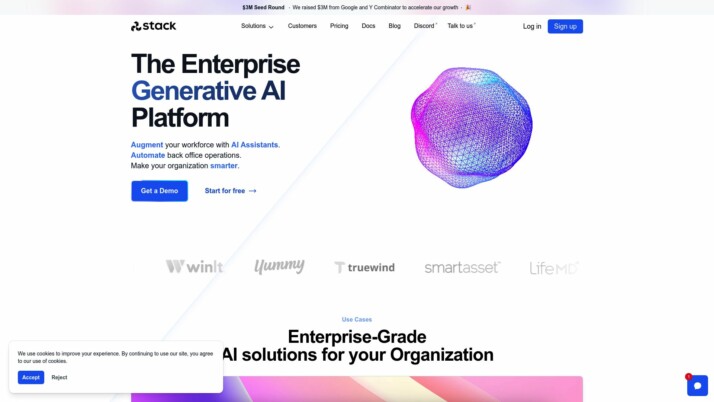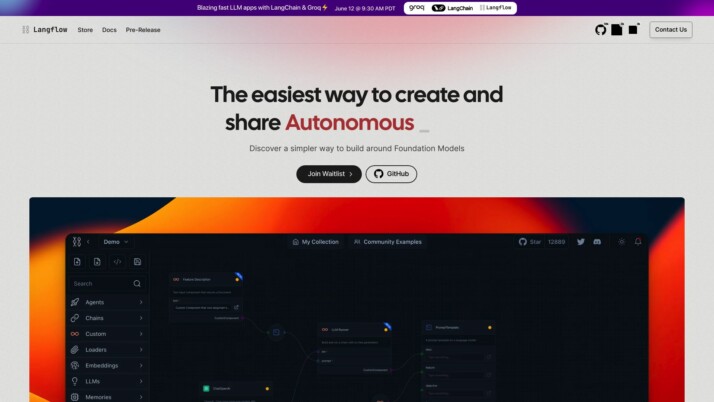Stack AI vs. Langflow: Comparing AI Workflow Platforms
AI development platforms are transforming how businesses harness machine learning capabilities. Stack AI vs. Langflow offer distinct approaches to building AI-powered workflows, each with unique strengths. Stack AI delivers enterprise-grade security and extensive integrations, while Langflow provides open-source flexibility for customization. This comparison examines how these platforms stack up against SmythOS, our comprehensive solution that combines user-friendly design with unparalleled scalability. We’ll explore key features, integration capabilities, and deployment options to help developers, business leaders, and AI enthusiasts choose the right tool for their AI development needs.
Stack AI Overview
Stack AI empowers users to create and deploy AI-powered workflows and custom AI assistants without extensive coding expertise. The platform’s low-code approach democratizes access to advanced AI capabilities, enabling businesses of all sizes to leverage artificial intelligence for process automation and enhanced decision-making.
Stack AI’s visual builder stands out with its intuitive drag-and-drop interface, allowing users to construct complex AI workflows effortlessly. This feature proves invaluable for organizations seeking to implement AI solutions rapidly without the need for specialized programming skills. The platform supports both development and production environments, facilitating seamless transition from testing to deployment.


Stack AI’s visual builder stands out with its intuitive drag-and-drop interface, allowing users to construct complex AI workflows effortlessly.
Security and compliance form core pillars of Stack AI’s offering. The platform adheres to SOC 2, HIPAA, and GDPR standards, ensuring robust data protection and privacy measures. This commitment to security makes Stack AI an attractive option for enterprises handling sensitive information, particularly in regulated industries such as healthcare and finance.
Stack AI excels in its integration capabilities, connecting seamlessly with popular business tools and data sources. This versatility allows users to incorporate AI-driven processes into existing workflows, enhancing productivity across various departments. The platform’s support for multiple deployment options, including APIs, webhooks, and chatbots, provides flexibility in how AI solutions are implemented and accessed.
While Stack AI offers numerous advantages, users should consider potential limitations. The platform’s emphasis on ease of use may result in less granular control for advanced users seeking highly customized AI implementations. Additionally, as with many cloud-based solutions, organizations must carefully evaluate data residency and sovereignty requirements to ensure compliance with specific regulatory frameworks.
Langflow Overview
Langflow empowers developers to create AI applications through an intuitive, low-code platform. This open-source tool simplifies the process of building complex AI workflows, making it accessible to users with varying levels of technical expertise.
At its core, Langflow offers a visual interface for constructing AI-driven systems. Users can drag and drop pre-built LangChain components, such as large language models and agents, to design sophisticated workflows without extensive coding. This approach significantly reduces the barrier to entry for AI development, enabling rapid prototyping and experimentation.
Langflow empowers developers to create AI applications through an intuitive, low-code platform. This open-source tool simplifies the process of building complex AI workflows…
Langflow prioritizes user-friendliness without sacrificing power. The platform provides a robust Command-Line Interface (CLI) for advanced users, allowing fine-grained control over project settings and configurations. Security remains a top priority, with enhanced login mechanisms and customizable authentication options, particularly beneficial for public deployments.


Langflow’s flexibility extends to its integration capabilities. The platform offers API key functionality for programmatic access to components and workflows. Users can export and import flows as JSON files, facilitating their use as Python objects or APIs. This interoperability enhances Langflow’s versatility across different development environments.
While Langflow excels in accessibility, it may present a learning curve for those entirely new to AI workflows. Additionally, its low-code approach, while powerful, might not offer the same level of granular control as high-code solutions for highly specialized needs. Scalability considerations may arise when handling extremely large-scale deployments or intricate workflows. Despite these potential limitations, Langflow’s vision of democratizing AI development positions it as a valuable tool for a wide range of users seeking to harness the power of AI in their projects and workflows.
Feature Comparison
Stack AI and Langflow both offer visual builders for creating AI workflows, but diverge in key areas. Stack AI provides hosted agents for development and production, while Langflow focuses on local deployment. This impacts scalability, with Stack AI offering more robust enterprise-grade solutions.
In terms of security, Stack AI emphasizes compliance with SOC 2, HIPAA, and GDPR standards. Langflow, as an open-source tool, relies more on user-implemented security measures. This difference is crucial for organizations handling sensitive data or operating in regulated industries.
Core components also differ significantly. Stack AI integrates with a wider range of foundation models and APIs, including those from OpenAI and Anthropic. Langflow, while flexible, primarily leverages LangChain components. This disparity affects the breadth of AI capabilities each platform can offer out-of-the-box.
We excel in these areas, offering unparalleled security features, extensive API integrations, and scalable hosted solutions. Our platform combines the best of both worlds — the flexibility of open-source tools with the robustness of enterprise-grade systems.
Feature Comparison Table
| Stack AI | Langflow | SmythOS | |
|---|---|---|---|
| CORE FEATURES | |||
| Problem-Solving Capabilities | ✅ | ❌ | ✅ |
| Work as Team | ✅ | ❌ | ✅ |
| Bulk Work | ✅ | ❌ | ✅ |
| Agent Work Scheduler | ✅ | ❌ | ✅ |
| SECURITY | |||
| Constrained Alignment | ❌ | ✅ | ✅ |
| Data Encryption | ✅ | ❌ | ✅ |
| IP Control | ❌ | ❌ | ✅ |
| COMPONENTS | |||
| Foundation AIs | ✅ | ❌ | ✅ |
| Huggingface AIs | ❌ | ✅ | ✅ |
| All other APIs, RPA | ✅ | ❌ | ✅ |
| DEPLOYMENT OPTIONS (EMBODIMENTS) | |||
| Deploy as API | ✅ | ❌ | ✅ |
| Production Domains | ✅ | ❌ | ✅ |
| API Authentication (OAuth + Key) | ✅ | ❌ | ✅ |
| Deploy as Site Chat | ✅ | ❌ | ✅ |
| Deploy as Scheduled Agent | ❌ | ✅ | ✅ |
| Deploy as GPT | ✅ | ❌ | ✅ |
| DATA LAKE SUPPORT | |||
| Sitemap Crawler | ❌ | ❌ | ✅ |
| YouTube Transcript Crawler | ❌ | ❌ | ✅ |
| URL Crawler | ✅ | ❌ | ✅ |
| PDF Support | ✅ | ❌ | ✅ |
Best Alternative to Stack AI and Langflow
SmythOS emerges as the superior alternative to Stack AI and Langflow, offering a comprehensive platform for AI agent development and deployment. Our solution combines the strengths of both competitors while addressing their limitations, providing users with a powerful, flexible, and user-friendly experience.
We excel in ease of use, featuring an intuitive drag-and-drop interface that surpasses both Stack AI and Langflow. This visual builder empowers users of all skill levels to create sophisticated AI workflows without extensive coding knowledge. Unlike Langflow’s focus on local deployment, we offer scalable hosted solutions for both development and production environments, ensuring enterprise-grade performance.
We excel in ease of use, featuring an intuitive drag-and-drop interface that surpasses both Stack AI and Langflow. This visual builder empowers users of all skill levels to create sophisticated AI workflows without extensive coding knowledge.
Security stands at the forefront of our platform. While Stack AI emphasizes compliance with industry standards, we go beyond by implementing robust data encryption, OAuth integration, and IP control features. This comprehensive approach to security makes us the ideal choice for organizations handling sensitive data or operating in regulated industries.
Our platform’s extensive integration capabilities set us apart from both competitors. We support a wide range of foundation models, APIs, and tools, including those from OpenAI, Anthropic, and Hugging Face. This versatility allows users to leverage cutting-edge AI technologies and seamlessly incorporate them into existing workflows. Additionally, our support for RPA and various data formats, including PDFs and Word files, further enhances our platform’s utility across diverse use cases.
Unlike Stack AI and Langflow, we offer unparalleled deployment flexibility. Our users can deploy AI agents as APIs, webhooks, scheduled tasks, or even as GPT models. This versatility, combined with our scalable infrastructure, positions us as the ideal solution for businesses looking to integrate AI seamlessly into their operations, regardless of size or industry.
Conclusion
Stack AI and Langflow offer compelling solutions for AI workflow creation, each with distinct advantages. Stack AI shines with its enterprise-grade security and extensive integrations, while Langflow’s open-source nature provides flexibility for customization. However, SmythOS elevates the AI development experience to new heights.
Our platform combines the best features of both competitors and adds unparalleled capabilities. We offer a visual builder that surpasses Stack AI’s ease of use, coupled with the extensibility of Langflow. SmythOS’s support for over 300,000 integrations dwarfs the offerings of both alternatives, allowing for unprecedented workflow possibilities.
Unlike our competitors, SmythOS provides true scalability with our “Create Once, Deploy Anywhere” approach. This unique feature allows users to build AI agents that seamlessly integrate across multiple platforms, from chatbots to APIs, and even as GPT plugins. Our robust security measures, including data encryption and OAuth support, ensure that your AI workflows remain protected, addressing concerns that open-source solutions like Langflow may struggle with.
For those seeking to harness the full potential of AI in their business processes, SmythOS stands out as the clear choice. Our platform not only matches the capabilities of Stack AI and Langflow but surpasses them in critical areas such as deployment options, scalability, and integration ecosystem. Explore our diverse range of AI-powered agent templates to jumpstart your AI journey and experience the future of workforce automation today.
Last updated:
Disclaimer: The information presented in this article is for general informational purposes only and is provided as is. While we strive to keep the content up-to-date and accurate, we make no representations or warranties of any kind, express or implied, about the completeness, accuracy, reliability, suitability, or availability of the information contained in this article.
Any reliance you place on such information is strictly at your own risk. We reserve the right to make additions, deletions, or modifications to the contents of this article at any time without prior notice.
In no event will we be liable for any loss or damage including without limitation, indirect or consequential loss or damage, or any loss or damage whatsoever arising from loss of data, profits, or any other loss not specified herein arising out of, or in connection with, the use of this article.
Despite our best efforts, this article may contain oversights, errors, or omissions. If you notice any inaccuracies or have concerns about the content, please report them through our content feedback form. Your input helps us maintain the quality and reliability of our information.
